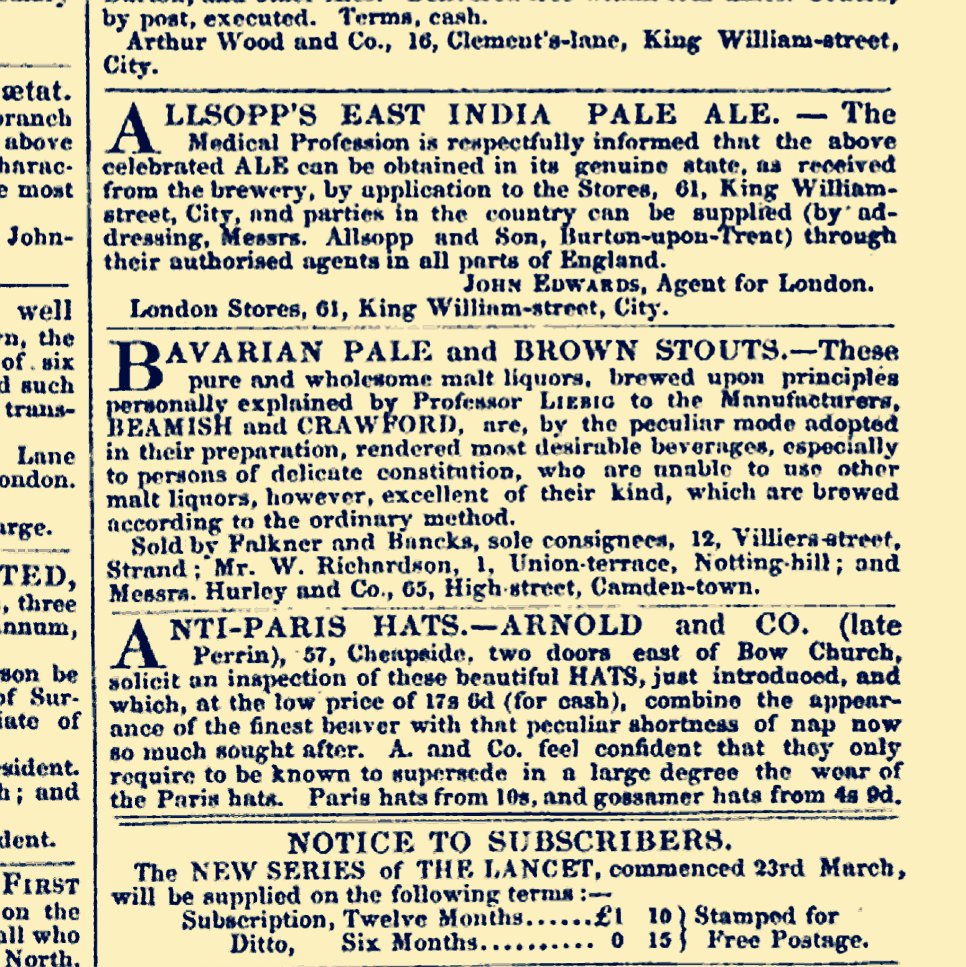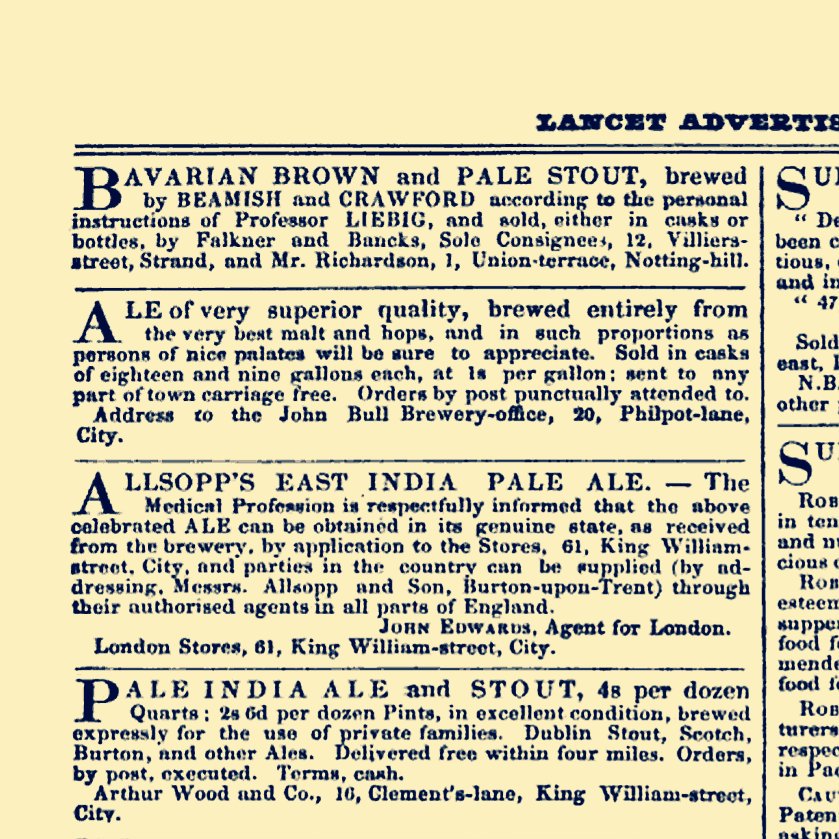Bottled Cooper
“What stuff is that?” growled out a passenger seated alongside the driver of omnibus the other day when he heard him smack his lips after swallowing a pint of new decoction and exclaiming “That’s first-rate.” The old roadster, looking sneeringly round, exclaimed “Don’t you know? Why, to be sure, its half porter and half stout.” The inquisitor was still dissatisfied asking, “Why call it Cooper?” This was enough to rile even a ’bus driver, at the same time feeling a thorough contempt, for such glaring ignorance that he weighed over to himself whether or no he should then satisfy his importunate companion ; but taking pity upon one evidently “from the country,” he ejaculated, “Oh, do you want to know that too ? Well, that’s easily answered. You must know that some time ago Jack Cooper, who used to drive one of the Brompton’s when be pulled up at the White Horse Cellar, Piccadilly, always had glass of this stuff; and the potboy seeing his ’bus pulled up, would always sing out – ‘Another glass of Cooper.’ The barmaid knew what was meant; but nobody else. Well, you see, this name got abroad, and now everyone does his Cooper. Take my advice, ‘Governor,’ when you feel dry take a drop.” Reader be very much obliged for this solution. Few people indeed know the origin of the word “Cooper.” Now, however, we have just had an improvement introduced in the shape of “Bottled Cooper.” Messrs. Beamish and Crawford, brewers, of Cork, who have had the supplying of the refreshment department the International Bazaar, and whose beers, by-the by, have been patronized for the quality and price, finding it necessary to have agent, appointed Mr. Henry Johnson, of the Circular Vaults, St. Paul’s; and him the public have to thank for the introduction of this popular drink. The idea suggested itself to him that what was palatable as draught drink would be doubly so when bottled.
Now I am certainly a fan of the odd piece of beer-related fan fiction but let us not put too much faith behind the story of the origin of the name 'Cooper' which is usually described as a half-and-half mix of stout and porter, and allegedly named after actual barrel coopers, but it does highlight a little known story about Beamish and Crawford's arrangement with Henry Johnson to sell their stouts in London. This is well covered in Beamish & Crawford - The History of an Irish Brewery, where a small chapter in the book explains, according to the authors, how Henry Johnson makes contact with Richard Pigott Beamish and how it was agreed that Johnson would sell a mix of their year-old Extra Treble Stout and Single Stout from his warehouse in London. It would be bottled there and sold with a nice bright label bearing the Beamish & Crawford name with a trademarked image of a castle flanked by two soldiers over the word 'Cooper', (I will not reproduce it here as I am unsure of copyright issues with posing even fragments of the above mentioned book.) and caged with branded corks, at a price 2s and 6d for a dozen pint bottles - cheaper than similar products and at what were said to be draught beer prices. (Although as you can see from the advert at the top of the page, some of Johnson's agents sold it for more.) There was even a recited advertising 'jingle' called, 'Where do you get your Cooper?' to accompany the launch.
It all ended in tears, as Johnson had both supply and quality issues (He apologised for both in the advertisement below.1) and was accused of using other brewer's beers instead of Beamish & Crawford's (Where did you get your Cooper indeed Mr. Johnson!?), so the brewery cut its ties with him at the end of April in 1863 and he was declared bankrupt not long afterwards. (A J. Hazard was selling 'The celebrated bottled Irish Cooper' in June of 1863 from the same address as Johnson's.2) You can read more about it in the book but it raises a few interesting points and I have other thoughts on it too...
The most important point perhaps is that I think that Cooper may have been the first Irish - or at least Irish brewed - beer to be marketed with a brand, jingle (I know I am taking liberties here...) and editorial advert? I am not aware of any others that existed this early anywhere else on these islands in fact, although I have not overly researched it to be fair. I would guess that it was certainly the first trademarked Irish-brewed beer ...
And there are a few more points to make too...
In August 1862 there were a couple of advertisements3 for Beamish and Crawford's Extra Treble Stout bottled with the above mentioned castle label and corks but not the Cooper name, this to my mind means that perhaps the whole range mentioned including the single and double stout had similar branding and perhaps the castle trademark covered all of the range, not just the later Cooper? The 'Cooper' appears to have been launched in September of that year, as it was not mentioned in those previous month's advertisements. Here is a copy of the first advertisement I can find for a beer with the Beamish & Crawford "Cooper" name and stating the blend - old vatted treble and single stouts - from the London Morning Post of the 1st of September.
It is worth noting that according to an advertisement for his Irish Cooper from March 1863 Johnson was then selling the unblended Extra Treble Stout. (Called 'The Burgundy of Ireland' according to some advertisements. Edit: This name was misattributed.) plus interestingly a 'Drogheda Strong Ale' as well as East India Pale Ale, but there was no sign of the single stout he supposedly blended with the triple.4 (By the way, directly above this March advert is one for bottled 'London Cooper' from Laidler and Fitch - some more local competition it seems!)
So was this the first bottled Cooper on the market? I can find some from Whitbread and others after this date but not before. And where did the bottled version actually originate if not Johnson, and Beamish and Crawford? In 1871 'The Cooper Company' claim to have originated the product in 1862 and were still selling it at the same price of 2s and 6d per dozen,5 so I'm quite confident that the bottled form of cooper - at the very least - originating from that original Cork-London partnership.
Next, in 1872 the following wonderful advertisement appears in the Islington Times:
This label is almost identical to that used by Beamish & Crawford and Johnson for their product apart from replacing their names with the name of the new company, and it still carries the trademarked logo. So does this mean that the Cork brewery were still supplying The Cooper Company or has all the branding and trademarks passed to that company when they bought out Johnson's bankrupt one? I suspect the latter and that Beamish & Crawford no longer had anything to do with it, certainly in the Beamish book I referenced above there is no mention of any continuation to supply after they withdrew from the arrangement.
Along with that advert there is an interesting report on a visit to The Cooper Company under the Hop Exchange on Southwark Street in London by a Percy Russel as part of a series of writeups under the title 'Metropolitan Industries'. In it he addresses the hygiene issues raised by a previous contributor to the newspaper with regard to brewing and bottling in general and he goes into some detail on the cleaning process for each bottle in the company's vault. More importantly for our story he also states that it is 'comforting to see by the branded barrels that the Irish stout does enter into the 'Cooper' and that the label is as true as a bank of England note.' He goes on to mention 'the happy blending of different brews' but annoyingly doesn't mention any of the actual brewers involved. He also mentions that The Cooper Company also export their beer to 'Shanghai, touched Tientsin, and even reached the Mikado of Japan himself.' (Indeed, according to an advertisement in The Times of India it was being sold in that country in 1877 too.)
In 1875 The Cooper Company were selling their Cooper at the same price as previously - and they were also selling Treble Dublin Stout by this time, as well as 'family' ale and India pale ale - and here is what they say about the Cooper product itself in an advertisement from this date:
The Cooper's Company Cooper is not plain porter, under the assumed name of Cooper, but is what the Cooper Company originally professed it to be - viz., Dublin Vatted Stout and London Porter. [My emphasis]6
So, that is somewhat of a change from what it started out as, and I think that perhaps this company was indeed formed on the ashes of Johnson's old company or was relaunched in this way by a former agent of his perhaps? (Johnson's stock of ports, sherry and 30 dozen bottles of Cooper were auctioned in November 1863.7) It would appear that the statement of what Cooper was in 1875 - although probably true at the time it was published - had been twisted to something more marketable, as Dublin Stout and London Porter were likely to be a more saleable commodity at this point, and readily available too. The irony is that given the shenanigans of Johnston that this later blend is quite possibly what he was actually selling to unsuspecting punters back in 1863!
At the end of the above mentioned advertisement the company also say they bottle Guinness Dublin Stout and Mander's Invalid Stout as well as an enigmatic 'Red Cross Treble Dublin Stout'. Mander's Invalid Stout was an XXX stout so I believe it was both the 'Red Cross' and the Dublin stout used to make the company's Cooper at this time, as it would make logical sense.
(Curiously, in 1886 Cundell and Camozzi in Tavistock were selling a bottled Cooper that was a mix of 'Stout and Bitter' for 2s per dozen.8 Make what you will of that blend, as it was just in an advertisement...)
Anyhow, as ever I have probably raised more questions than I have actually answered, but it is good to get this part of Ireland's - and London's - brewing history online and findable for others.
Perhaps some Cork brewery might revive the 'Celebrated Irish Cooper', or maybe a Dublin and a London brewery could do a collaboration?
Just don't forget the marketing, the trademark - and to write that jingle!
(All written content and the research involved in publishing it here is my own unless otherwise stated and can not be reproduced elsewhere without full credit to its source and a link back to this post.)
1London Evening Standard - Monday 09 March 1863
2 Illustrated Weekly News - Saturday 27 June 1863
3 London Evening Standard - Thursday 28 August 1862
4 London Evening Standard - Tuesday 17 March 1863
5 Stroud News and Gloucestershire Advertiser - Friday 18 August 1871
6 Kilburn Times - Saturday 10 July 1875
7 London City Press - Saturday 31 October 1863
8 Tavistock Gazette - Friday 05 November 1886
All via The British Newspaper Archive and Beamish & Crawford - The History of an Irish Brewery (2015) by Donal Ó Drisceoil and Diarmuid Ó Drisceoil
Newspaper images © The British Library Board. All rights reserved. With thanks to The British Newspaper Archive (www.britishnewspaperarchive.co.uk).











